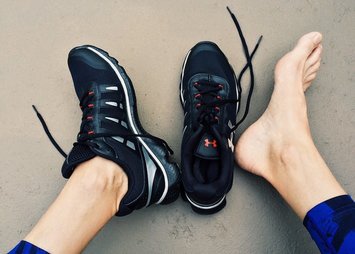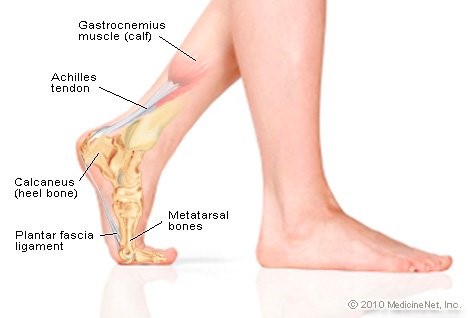My Heel Hurts!! Could It Be Plantar Fasciitis??
Apr 13, 2020

One doesn’t have to be an athlete in order to experience many conditions that seem to be related to athletic activities and exercise. One of these conditions we often see in our clinic, no matter if you are an athlete or not, is Plantar Fasciitis. This is a condition characterized by inflammation and pain of the plantar fascia, a thick band of tissue located on the bottom of the foot that connects the heel bone (calcaneus) to the toes. This pain is typically a sharp or stabbing pain usually located at the front of the heel on the bottom of the foot where the fascia inserts into the heel. This pain is much worse in the mornings when arising out of bed and attempting to walk. The pain may come and go during the day but will usually reoccur when one stands up after sitting for some time.
Causes of plantar fasciitis can be any of the following:
- Becoming more active, especially in a weight bearing activity
- Weight fluctuations
- Changes in shoes. Oftentimes a particular shoe will create stresses in the foot
- Shoe wear
- Changes in one’s stance or gait stemming from a condition or injury in another joint or muscle in the leg, foot, or the pelvis that makes one compensate for that area.
- One or more of the 3 arches of the foot are breaking down
In looking at the picture below, see the plantar fascia location and how it attaches to the front of the bottom of the heel. Also look at the calf muscle and the attached Achilles tendon.When one’s calf muscles get overly tight or overly used, this can pull up on the heel bone and “load” the fascia making it also very taut. This situation will exert undue stress at the attachment of the plantar fascia onto the heel, eventually creating inflammation. This is the reason why there is pain at the insertion of the fascial insertion when one stands up while flattening the arches of the feet. (See this video for calf stretches.)
Treatment options for plantar fasciitis are many with much of the work done at home by the patient.
1. One must try and keep the calves loose. Frequent stretching of the calves will take some of the tension off of the fascia. (See YouTube video HERE. Be sure to subscribe.)
2. Arches must be addressed whether they be flat or are just starting to get lower, they need to be supported. Sometimes a change in shoes will help. Often, a specific prescription orthotic needs to be worn during all weight bearing.In our clinic we use a scanner that determines which arches need to be supported and by how much – in each foot.
3. Many times, rolling the arches with a golf ball, a tennis ball, or a cold can could help the arches be more supple
4. Since the arches and the fascia have a tendency to shorten during the night, I recommend that in the mornings, as soon as possible, the feet need to be heated and then stretched or rolled in order to help elongate the fascia without re-inflaming the insertion so much.
5. Then, at night, icing the area of the fascial insertion is helpful.
6. Several modalities such as laser therapy and trigger point dry needling often help with loosening the tissue and stimulating it to heel.
7. Going barefoot has a tendency to exert increased pressure on the insertion of the fascial and can perpetuate the problem.I’ll tell my patients to slip on a pair of house “shoes” that have an arch in them when they want to go barefoot.
8. Certain exercises utilizing the toes and muscles of the feet are also helpful in maintaining the arches.

Plantar fasciitis can be difficult to work through. But the closer one can follow the above guidelines and seek treatment the quicker one should get over the condition. Sometimes this may require the orthotics to be worn in the shoes in combination with the above guidelines, in which case we will be able to do that in the clinic.
If plantar fasciitis has been giving you a “pain in the foot”, give our clinic a call. Any of our doctors will be able to help you and get you back to walking without the stabbing pain in the foot.